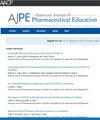Implementation and Evaluation of Entrustable Professional Activities for a Pharmacy Intern Training Program in Australia
IF 3.8
4区 教育学
Q1 EDUCATION, SCIENTIFIC DISCIPLINES
引用次数: 0
Abstract
Objective
This study aimed to describe the implementation and evaluation of entrustable professional activities (EPAs) for a pharmacy intern training program in Australia.
Methods
Surveys and focus groups were used to evaluate the perceptions and experiences of provisionally registered pharmacists and pharmacists using the EPAs as an assessment tool in the workplace. Thematic analysis was used to analyze the focus group data. Surveys compared the frequency and median responses to the Likert-scale items. Entrustment levels at 6, 13, 26, and 44 weeks were reported for each EPA.
Results
Pharmacist (n = 6) and provisionally registered pharmacist (n = 8) focus groups identified the following themes: use of EPAs in the workplace, benefits and challenges of using EPAs, and future direction and recommendations for using EPAs in the workplace. Feasibility measures in the pharmacist survey suggested that pharmacists were satisfied with using EPAs in the workplace. The provisionally registered pharmacist survey showed that they valued feedback provided by pharmacists and that they engaged with the EPAs in the workplace. Provisionally registered pharmacists enrolled in the study (n = 40) showed progression in entrustment levels at each reporting period.
Conclusion
Pharmacists and provisionally registered pharmacists reported that EPAs were feasible and could be used in the workplace as an educative tool. However, they highlighted education as an important factor for successful implementation. At each milestone, provisionally registered pharmacists showed progression in entrustment level.
澳大利亚药学实习生培训计划中可委托专业活动的实施与评估。
研究目的本研究旨在描述澳大利亚药房实习生培训计划中 "可委托专业活动"(EPAs)的实施和评估情况:采用调查和焦点小组的方式,评估临时注册药剂师和药剂师在工作场所将 EPAs 作为评估工具的看法和经验。专题分析用于分析焦点小组数据。调查比较了对李克特量表项目的回答频率和中位数。报告了每项 EPA 在 6 周、13 周、26 周和 44 周的委托水平:药剂师(6 人)和临时注册药剂师(8 人)焦点小组确定了以下主题:在工作场所使用 EPA、使用 EPA 的益处和挑战以及在工作场所使用 EPA 的未来方向和建议。药剂师调查中的可行性措施表明,药剂师对在工作场所使用持久性有机污染物感到满意。临时注册药剂师调查显示,他们重视药剂师提供的反馈意见,并在工作场所参与使用持久性有机污染物。参与研究的临时注册药剂师(n=40)在每个报告期的委托水平都有所提高:药剂师和临时注册药剂师表示,EPAs 是可行的,可以在工作场所作为教育工具使用,但强调了教育作为成功实施的重要因素的重要性。在每个里程碑上,临时注册药剂师的委托水平都有所提高。
本文章由计算机程序翻译,如有差异,请以英文原文为准。
求助全文
约1分钟内获得全文
求助全文
来源期刊
CiteScore
4.30
自引率
15.20%
发文量
114
期刊介绍:
The Journal accepts unsolicited manuscripts that have not been published and are not under consideration for publication elsewhere. The Journal only considers material related to pharmaceutical education for publication. Authors must prepare manuscripts to conform to the Journal style (Author Instructions). All manuscripts are subject to peer review and approval by the editor prior to acceptance for publication. Reviewers are assigned by the editor with the advice of the editorial board as needed. Manuscripts are submitted and processed online (Submit a Manuscript) using Editorial Manager, an online manuscript tracking system that facilitates communication between the editorial office, editor, associate editors, reviewers, and authors.
After a manuscript is accepted, it is scheduled for publication in an upcoming issue of the Journal. All manuscripts are formatted and copyedited, and returned to the author for review and approval of the changes. Approximately 2 weeks prior to publication, the author receives an electronic proof of the article for final review and approval. Authors are not assessed page charges for publication.

 求助内容:
求助内容: 应助结果提醒方式:
应助结果提醒方式:


